BUACC5932 - Corporate Accounting
VerifiedAdded on 2021/05/30
|13
|2939
|23
AI Summary
Contribute Materials
Your contribution can guide someone’s learning journey. Share your
documents today.
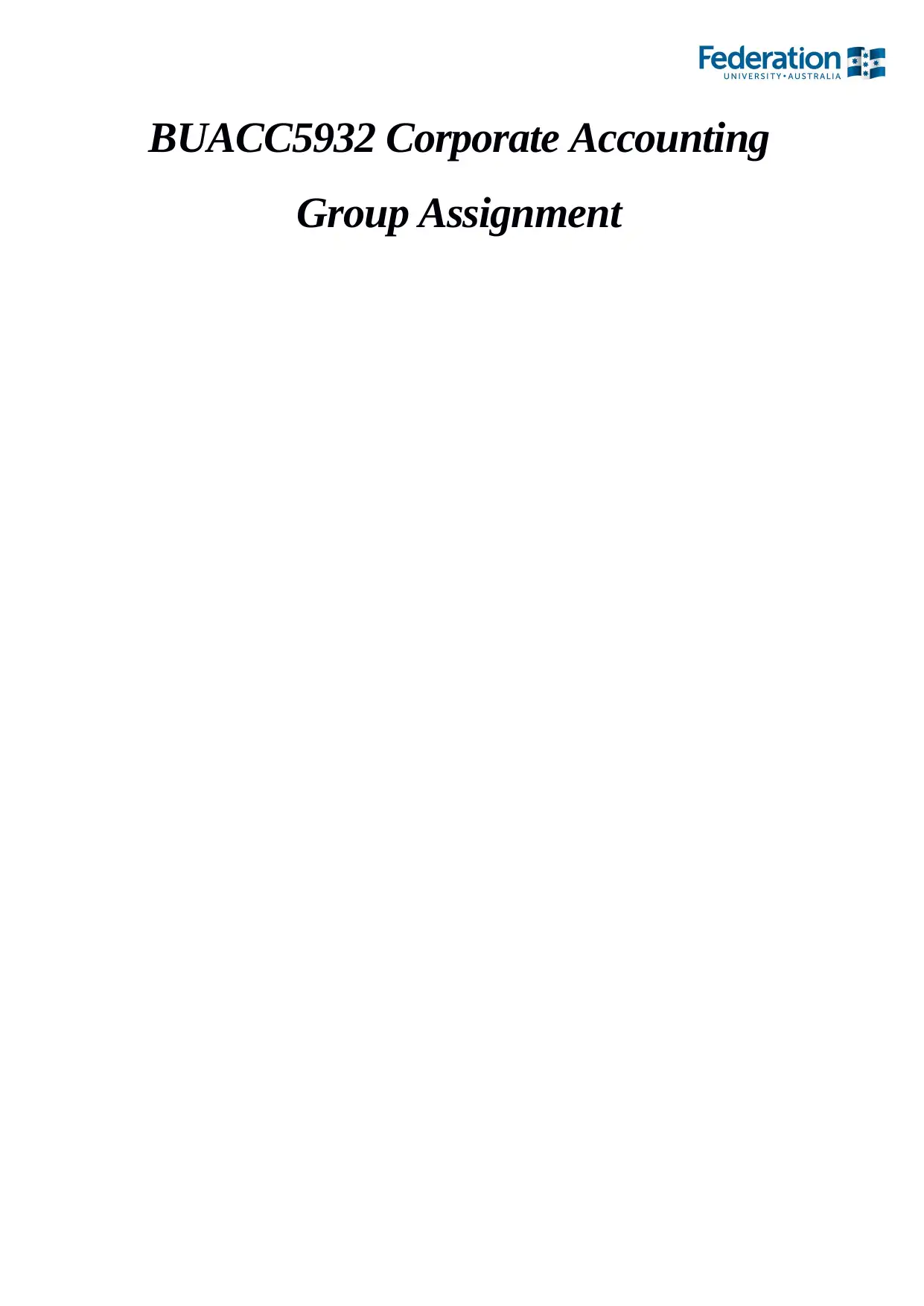
BUACC5932 Corporate Accounting
Group Assignment
Group Assignment
Secure Best Marks with AI Grader
Need help grading? Try our AI Grader for instant feedback on your assignments.
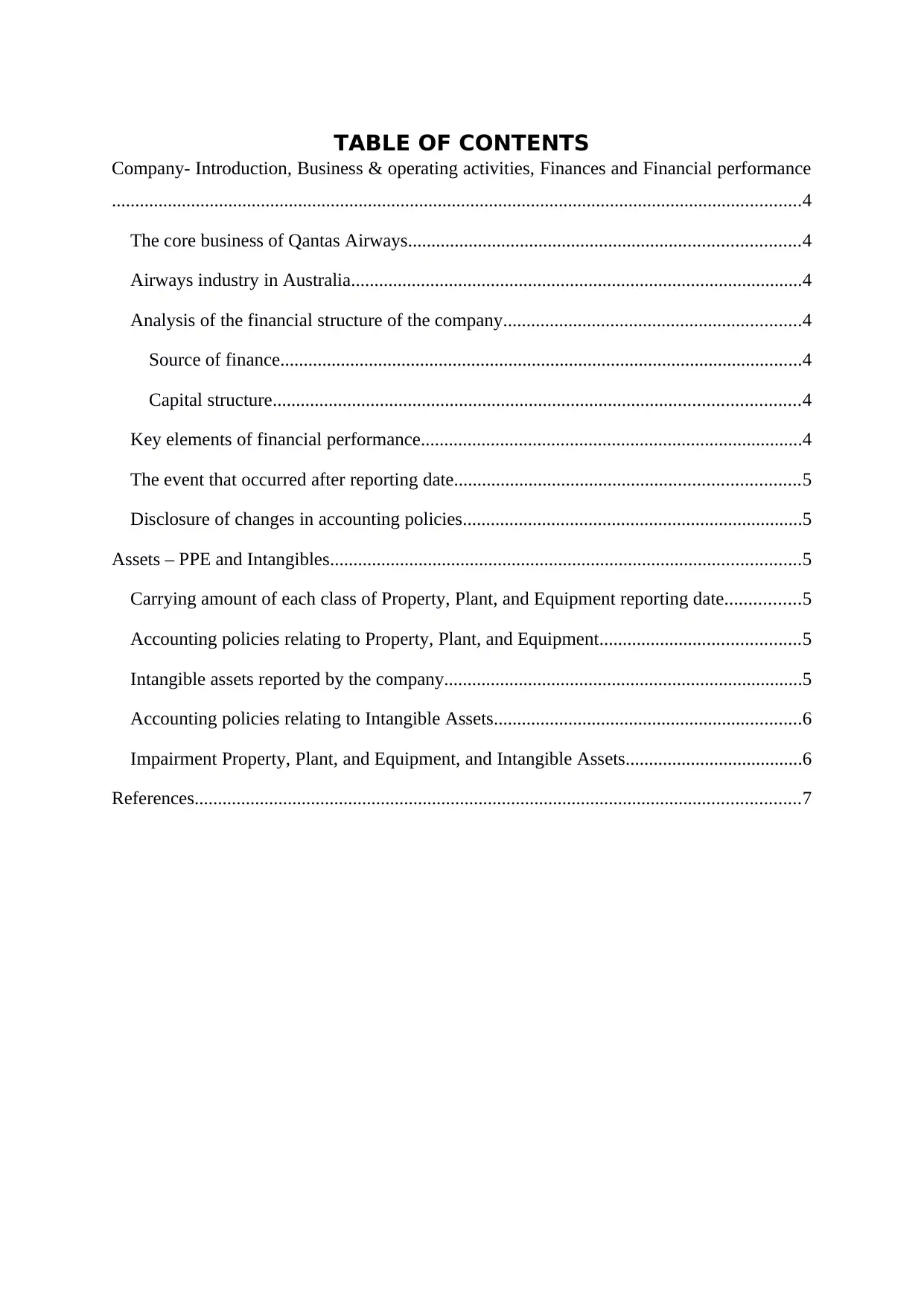
TABLE OF CONTENTS
Company- Introduction, Business & operating activities, Finances and Financial performance
....................................................................................................................................................4
The core business of Qantas Airways....................................................................................4
Airways industry in Australia.................................................................................................4
Analysis of the financial structure of the company................................................................4
Source of finance................................................................................................................4
Capital structure.................................................................................................................4
Key elements of financial performance..................................................................................4
The event that occurred after reporting date..........................................................................5
Disclosure of changes in accounting policies.........................................................................5
Assets – PPE and Intangibles.....................................................................................................5
Carrying amount of each class of Property, Plant, and Equipment reporting date................5
Accounting policies relating to Property, Plant, and Equipment...........................................5
Intangible assets reported by the company.............................................................................5
Accounting policies relating to Intangible Assets..................................................................6
Impairment Property, Plant, and Equipment, and Intangible Assets......................................6
References..................................................................................................................................7
Company- Introduction, Business & operating activities, Finances and Financial performance
....................................................................................................................................................4
The core business of Qantas Airways....................................................................................4
Airways industry in Australia.................................................................................................4
Analysis of the financial structure of the company................................................................4
Source of finance................................................................................................................4
Capital structure.................................................................................................................4
Key elements of financial performance..................................................................................4
The event that occurred after reporting date..........................................................................5
Disclosure of changes in accounting policies.........................................................................5
Assets – PPE and Intangibles.....................................................................................................5
Carrying amount of each class of Property, Plant, and Equipment reporting date................5
Accounting policies relating to Property, Plant, and Equipment...........................................5
Intangible assets reported by the company.............................................................................5
Accounting policies relating to Intangible Assets..................................................................6
Impairment Property, Plant, and Equipment, and Intangible Assets......................................6
References..................................................................................................................................7
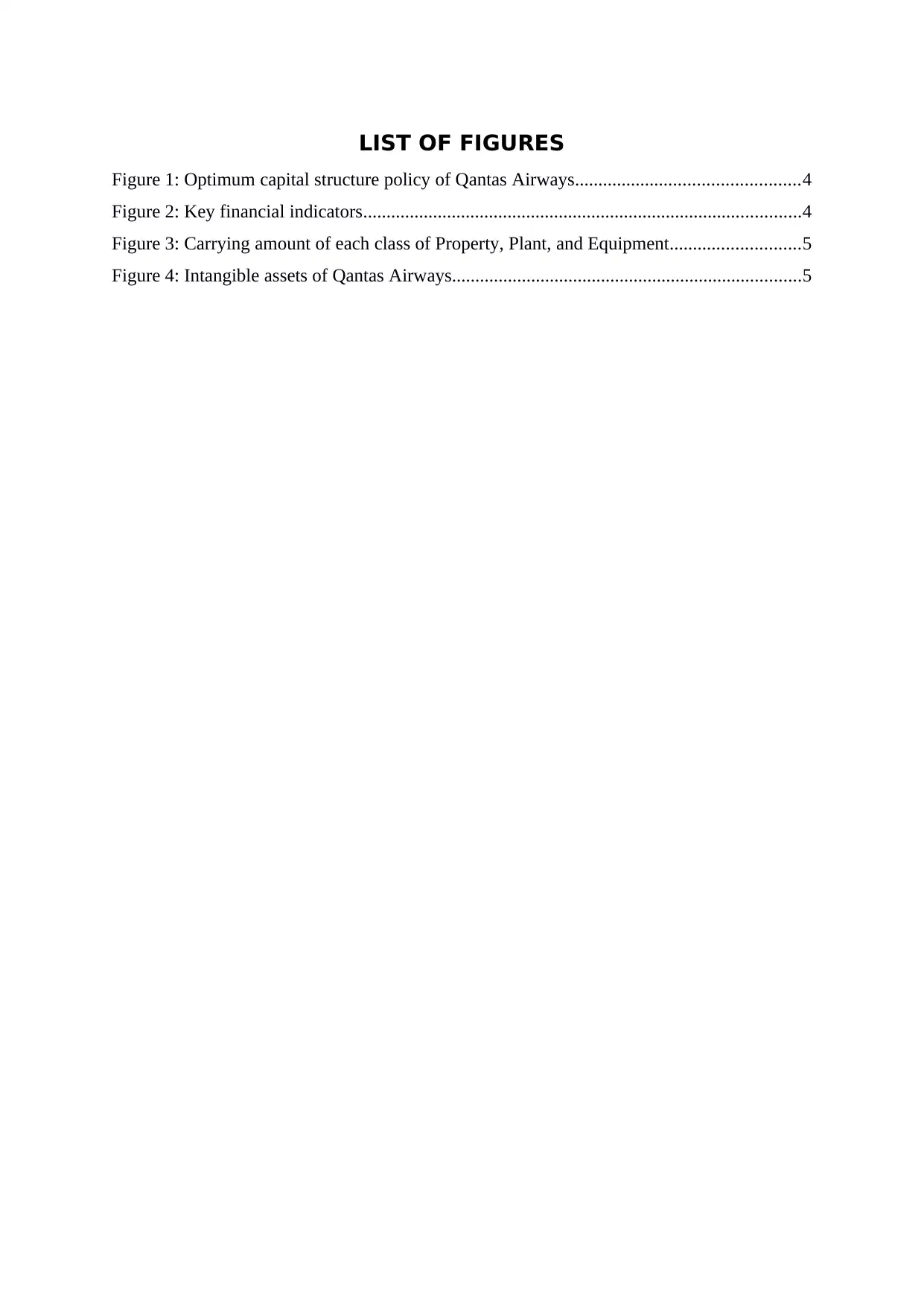
LIST OF FIGURES
Figure 1: Optimum capital structure policy of Qantas Airways................................................4
Figure 2: Key financial indicators..............................................................................................4
Figure 3: Carrying amount of each class of Property, Plant, and Equipment............................5
Figure 4: Intangible assets of Qantas Airways...........................................................................5
Figure 1: Optimum capital structure policy of Qantas Airways................................................4
Figure 2: Key financial indicators..............................................................................................4
Figure 3: Carrying amount of each class of Property, Plant, and Equipment............................5
Figure 4: Intangible assets of Qantas Airways...........................................................................5
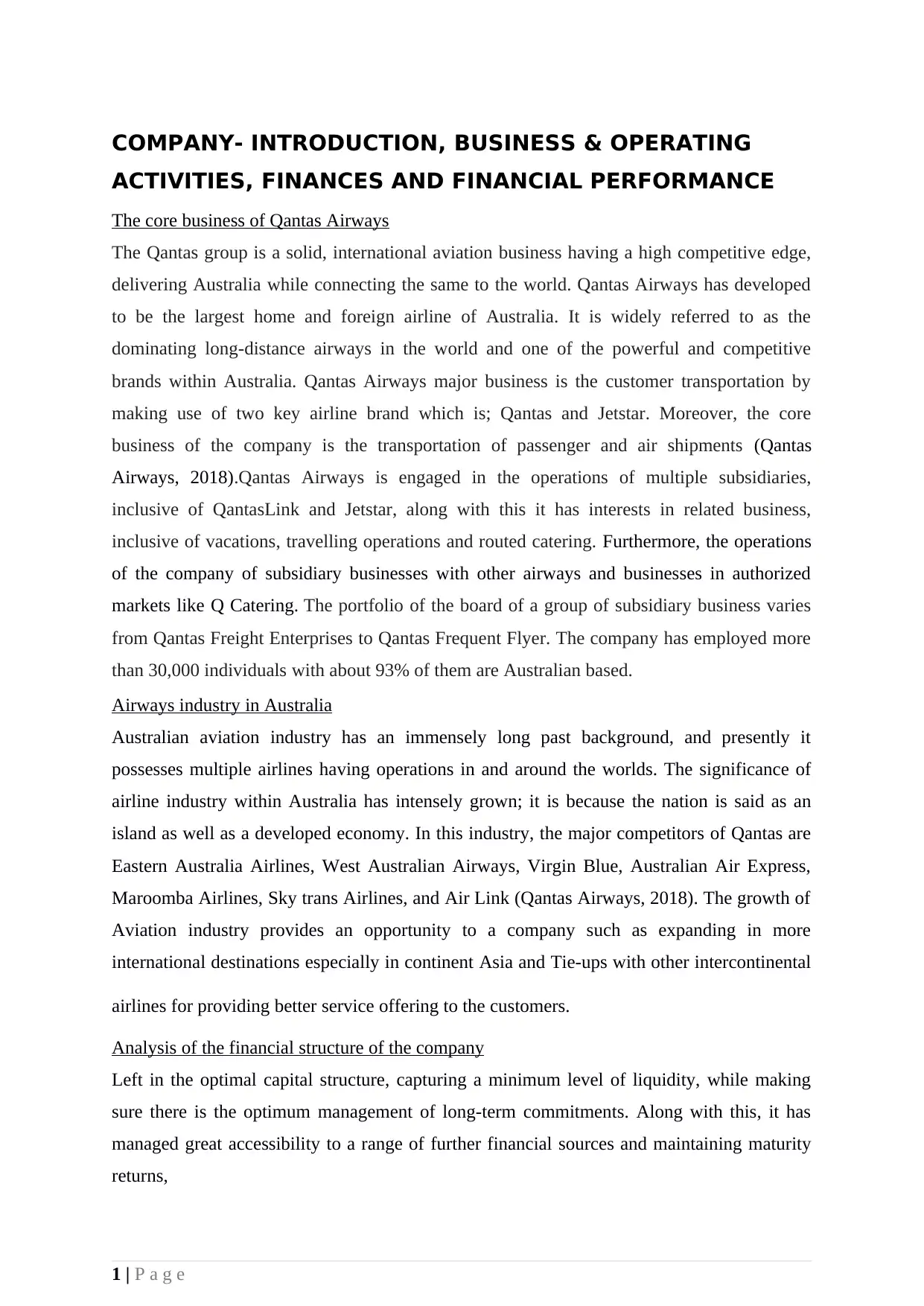
COMPANY- INTRODUCTION, BUSINESS & OPERATING
ACTIVITIES, FINANCES AND FINANCIAL PERFORMANCE
The core business of Qantas Airways
The Qantas group is a solid, international aviation business having a high competitive edge,
delivering Australia while connecting the same to the world. Qantas Airways has developed
to be the largest home and foreign airline of Australia. It is widely referred to as the
dominating long-distance airways in the world and one of the powerful and competitive
brands within Australia. Qantas Airways major business is the customer transportation by
making use of two key airline brand which is; Qantas and Jetstar. Moreover, the core
business of the company is the transportation of passenger and air shipments (Qantas
Airways, 2018).Qantas Airways is engaged in the operations of multiple subsidiaries,
inclusive of QantasLink and Jetstar, along with this it has interests in related business,
inclusive of vacations, travelling operations and routed catering. Furthermore, the operations
of the company of subsidiary businesses with other airways and businesses in authorized
markets like Q Catering. The portfolio of the board of a group of subsidiary business varies
from Qantas Freight Enterprises to Qantas Frequent Flyer. The company has employed more
than 30,000 individuals with about 93% of them are Australian based.
Airways industry in Australia
Australian aviation industry has an immensely long past background, and presently it
possesses multiple airlines having operations in and around the worlds. The significance of
airline industry within Australia has intensely grown; it is because the nation is said as an
island as well as a developed economy. In this industry, the major competitors of Qantas are
Eastern Australia Airlines, West Australian Airways, Virgin Blue, Australian Air Express,
Maroomba Airlines, Sky trans Airlines, and Air Link (Qantas Airways, 2018). The growth of
Aviation industry provides an opportunity to a company such as expanding in more
international destinations especially in continent Asia and Tie-ups with other intercontinental
airlines for providing better service offering to the customers.
Analysis of the financial structure of the company
Left in the optimal capital structure, capturing a minimum level of liquidity, while making
sure there is the optimum management of long-term commitments. Along with this, it has
managed great accessibility to a range of further financial sources and maintaining maturity
returns,
1 | P a g e
ACTIVITIES, FINANCES AND FINANCIAL PERFORMANCE
The core business of Qantas Airways
The Qantas group is a solid, international aviation business having a high competitive edge,
delivering Australia while connecting the same to the world. Qantas Airways has developed
to be the largest home and foreign airline of Australia. It is widely referred to as the
dominating long-distance airways in the world and one of the powerful and competitive
brands within Australia. Qantas Airways major business is the customer transportation by
making use of two key airline brand which is; Qantas and Jetstar. Moreover, the core
business of the company is the transportation of passenger and air shipments (Qantas
Airways, 2018).Qantas Airways is engaged in the operations of multiple subsidiaries,
inclusive of QantasLink and Jetstar, along with this it has interests in related business,
inclusive of vacations, travelling operations and routed catering. Furthermore, the operations
of the company of subsidiary businesses with other airways and businesses in authorized
markets like Q Catering. The portfolio of the board of a group of subsidiary business varies
from Qantas Freight Enterprises to Qantas Frequent Flyer. The company has employed more
than 30,000 individuals with about 93% of them are Australian based.
Airways industry in Australia
Australian aviation industry has an immensely long past background, and presently it
possesses multiple airlines having operations in and around the worlds. The significance of
airline industry within Australia has intensely grown; it is because the nation is said as an
island as well as a developed economy. In this industry, the major competitors of Qantas are
Eastern Australia Airlines, West Australian Airways, Virgin Blue, Australian Air Express,
Maroomba Airlines, Sky trans Airlines, and Air Link (Qantas Airways, 2018). The growth of
Aviation industry provides an opportunity to a company such as expanding in more
international destinations especially in continent Asia and Tie-ups with other intercontinental
airlines for providing better service offering to the customers.
Analysis of the financial structure of the company
Left in the optimal capital structure, capturing a minimum level of liquidity, while making
sure there is the optimum management of long-term commitments. Along with this, it has
managed great accessibility to a range of further financial sources and maintaining maturity
returns,
1 | P a g e
Secure Best Marks with AI Grader
Need help grading? Try our AI Grader for instant feedback on your assignments.
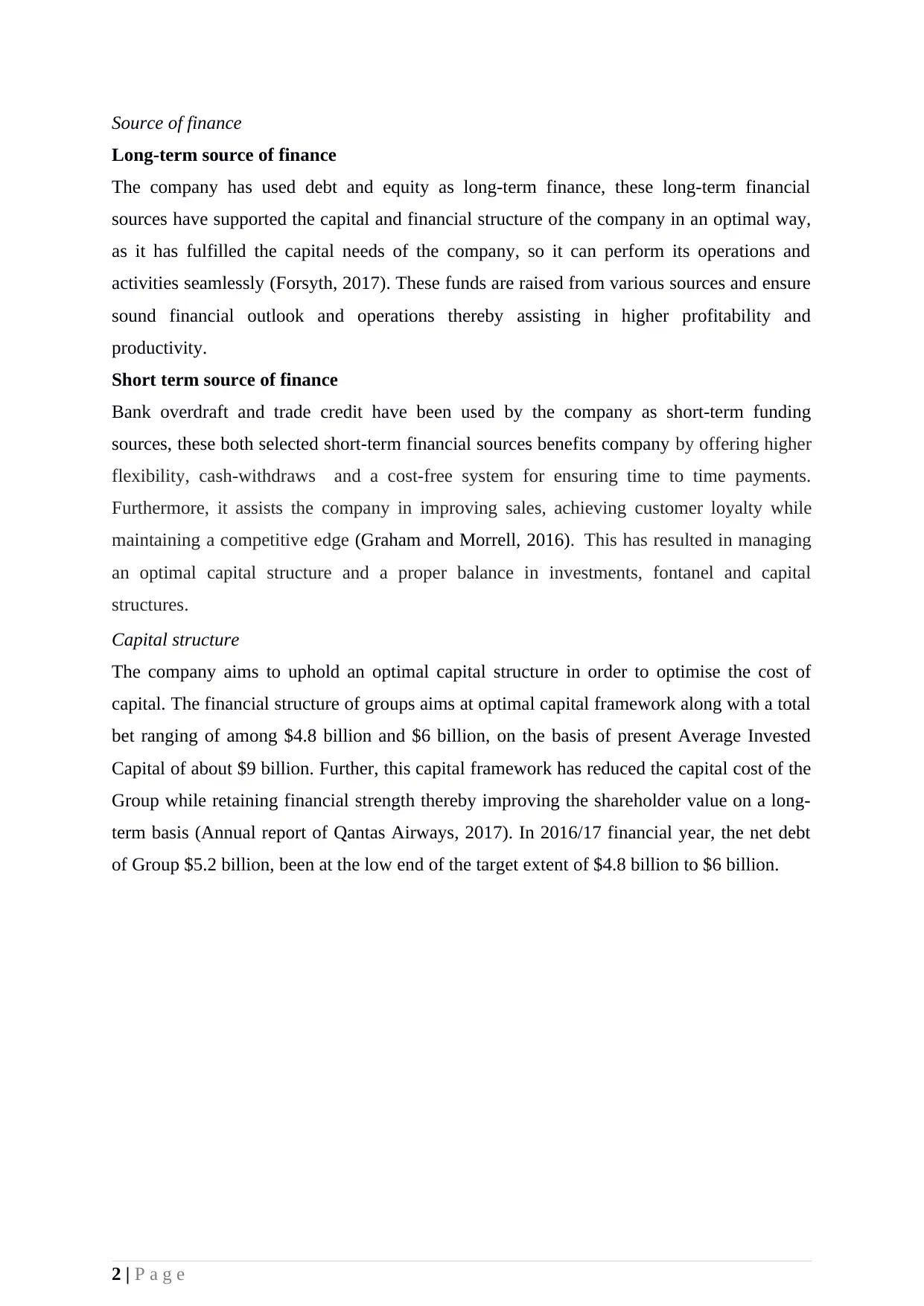
Source of finance
Long-term source of finance
The company has used debt and equity as long-term finance, these long-term financial
sources have supported the capital and financial structure of the company in an optimal way,
as it has fulfilled the capital needs of the company, so it can perform its operations and
activities seamlessly (Forsyth, 2017). These funds are raised from various sources and ensure
sound financial outlook and operations thereby assisting in higher profitability and
productivity.
Short term source of finance
Bank overdraft and trade credit have been used by the company as short-term funding
sources, these both selected short-term financial sources benefits company by offering higher
flexibility, cash-withdraws and a cost-free system for ensuring time to time payments.
Furthermore, it assists the company in improving sales, achieving customer loyalty while
maintaining a competitive edge (Graham and Morrell, 2016). This has resulted in managing
an optimal capital structure and a proper balance in investments, fontanel and capital
structures.
Capital structure
The company aims to uphold an optimal capital structure in order to optimise the cost of
capital. The financial structure of groups aims at optimal capital framework along with a total
bet ranging of among $4.8 billion and $6 billion, on the basis of present Average Invested
Capital of about $9 billion. Further, this capital framework has reduced the capital cost of the
Group while retaining financial strength thereby improving the shareholder value on a long-
term basis (Annual report of Qantas Airways, 2017). In 2016/17 financial year, the net debt
of Group $5.2 billion, been at the low end of the target extent of $4.8 billion to $6 billion.
2 | P a g e
Long-term source of finance
The company has used debt and equity as long-term finance, these long-term financial
sources have supported the capital and financial structure of the company in an optimal way,
as it has fulfilled the capital needs of the company, so it can perform its operations and
activities seamlessly (Forsyth, 2017). These funds are raised from various sources and ensure
sound financial outlook and operations thereby assisting in higher profitability and
productivity.
Short term source of finance
Bank overdraft and trade credit have been used by the company as short-term funding
sources, these both selected short-term financial sources benefits company by offering higher
flexibility, cash-withdraws and a cost-free system for ensuring time to time payments.
Furthermore, it assists the company in improving sales, achieving customer loyalty while
maintaining a competitive edge (Graham and Morrell, 2016). This has resulted in managing
an optimal capital structure and a proper balance in investments, fontanel and capital
structures.
Capital structure
The company aims to uphold an optimal capital structure in order to optimise the cost of
capital. The financial structure of groups aims at optimal capital framework along with a total
bet ranging of among $4.8 billion and $6 billion, on the basis of present Average Invested
Capital of about $9 billion. Further, this capital framework has reduced the capital cost of the
Group while retaining financial strength thereby improving the shareholder value on a long-
term basis (Annual report of Qantas Airways, 2017). In 2016/17 financial year, the net debt
of Group $5.2 billion, been at the low end of the target extent of $4.8 billion to $6 billion.
2 | P a g e
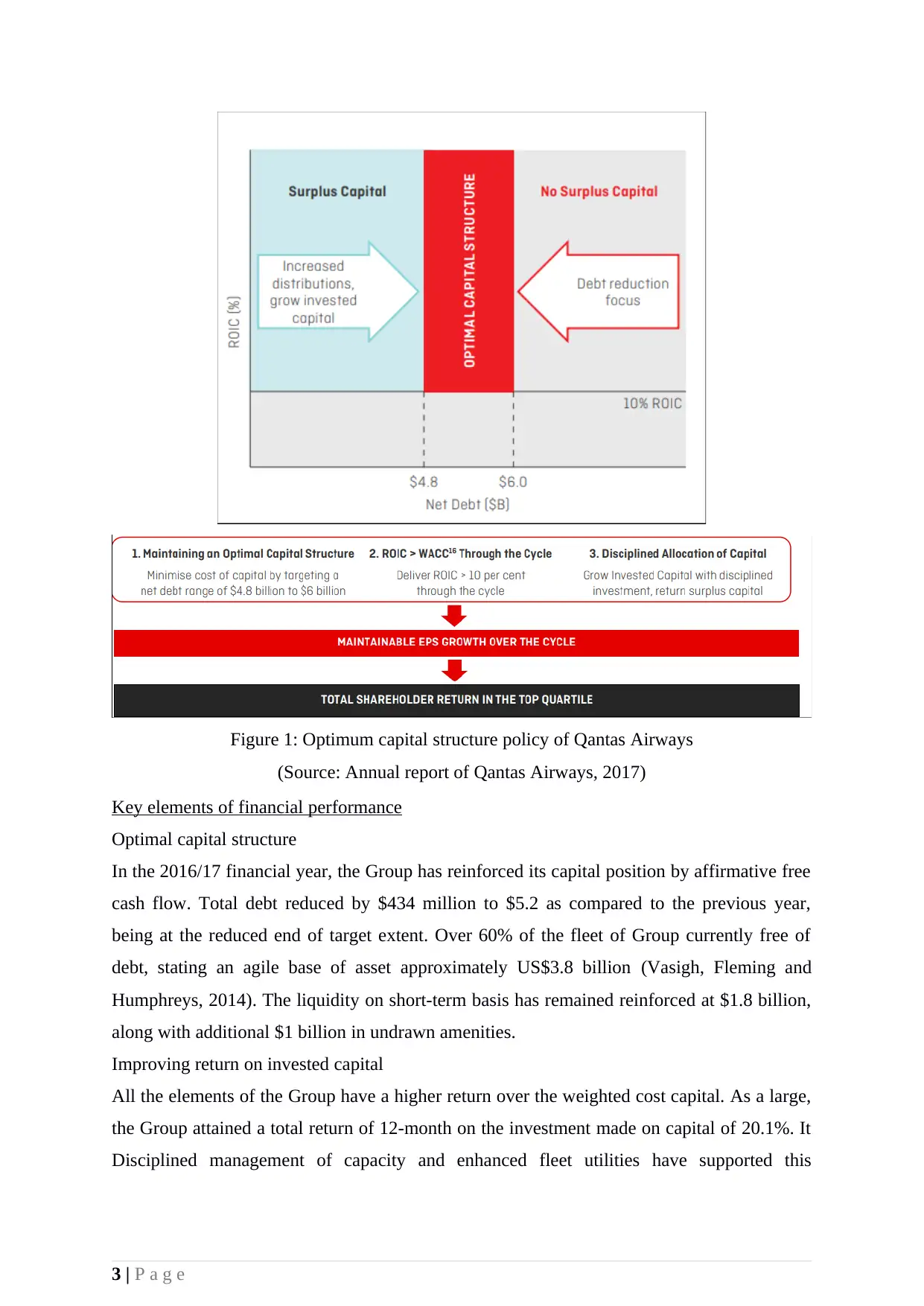
Figure 1: Optimum capital structure policy of Qantas Airways
(Source: Annual report of Qantas Airways, 2017)
Key elements of financial performance
Optimal capital structure
In the 2016/17 financial year, the Group has reinforced its capital position by affirmative free
cash flow. Total debt reduced by $434 million to $5.2 as compared to the previous year,
being at the reduced end of target extent. Over 60% of the fleet of Group currently free of
debt, stating an agile base of asset approximately US$3.8 billion (Vasigh, Fleming and
Humphreys, 2014). The liquidity on short-term basis has remained reinforced at $1.8 billion,
along with additional $1 billion in undrawn amenities.
Improving return on invested capital
All the elements of the Group have a higher return over the weighted cost capital. As a large,
the Group attained a total return of 12-month on the investment made on capital of 20.1%. It
Disciplined management of capacity and enhanced fleet utilities have supported this
3 | P a g e
(Source: Annual report of Qantas Airways, 2017)
Key elements of financial performance
Optimal capital structure
In the 2016/17 financial year, the Group has reinforced its capital position by affirmative free
cash flow. Total debt reduced by $434 million to $5.2 as compared to the previous year,
being at the reduced end of target extent. Over 60% of the fleet of Group currently free of
debt, stating an agile base of asset approximately US$3.8 billion (Vasigh, Fleming and
Humphreys, 2014). The liquidity on short-term basis has remained reinforced at $1.8 billion,
along with additional $1 billion in undrawn amenities.
Improving return on invested capital
All the elements of the Group have a higher return over the weighted cost capital. As a large,
the Group attained a total return of 12-month on the investment made on capital of 20.1%. It
Disciplined management of capacity and enhanced fleet utilities have supported this
3 | P a g e
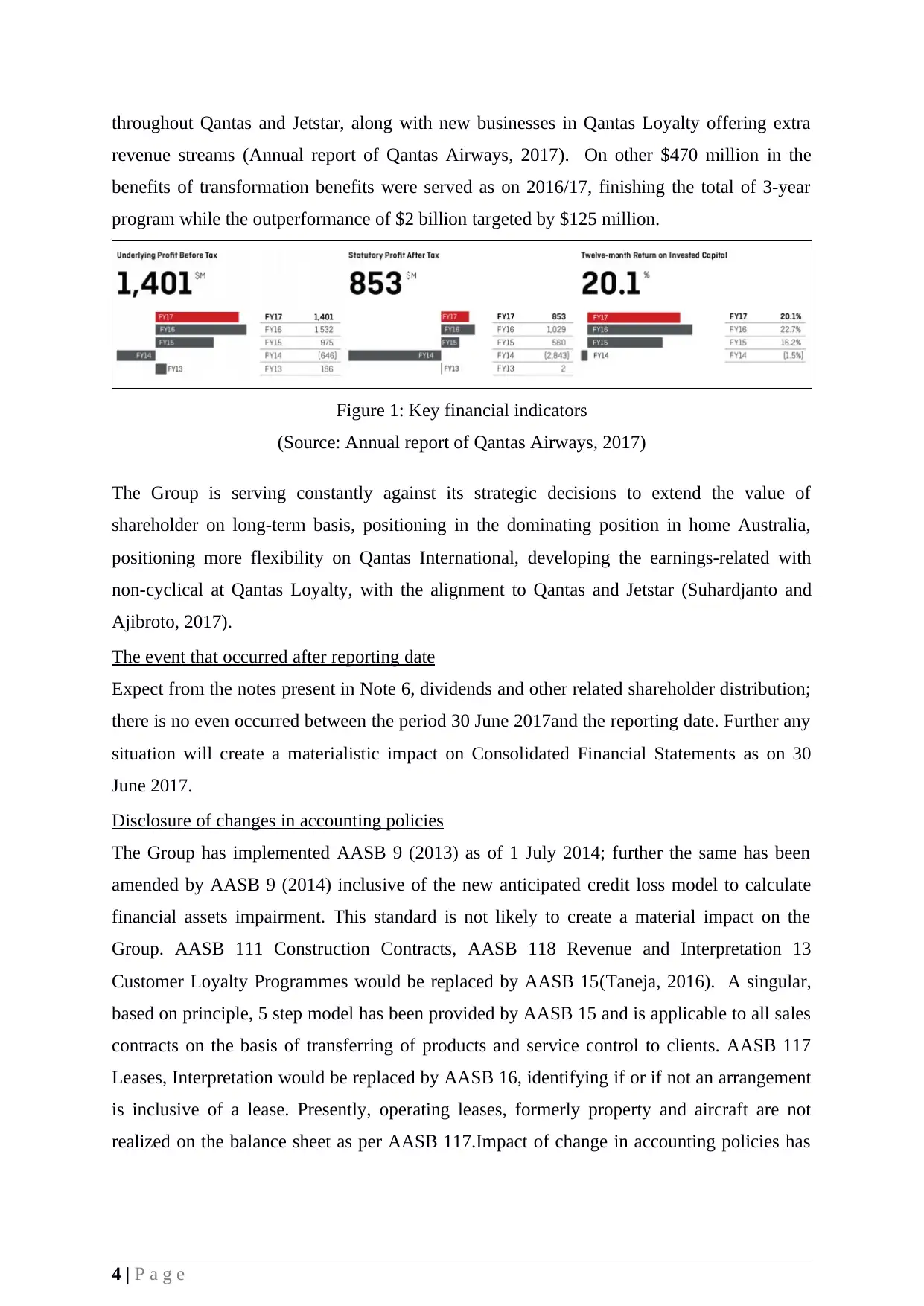
throughout Qantas and Jetstar, along with new businesses in Qantas Loyalty offering extra
revenue streams (Annual report of Qantas Airways, 2017). On other $470 million in the
benefits of transformation benefits were served as on 2016/17, finishing the total of 3-year
program while the outperformance of $2 billion targeted by $125 million.
Figure 1: Key financial indicators
(Source: Annual report of Qantas Airways, 2017)
The Group is serving constantly against its strategic decisions to extend the value of
shareholder on long-term basis, positioning in the dominating position in home Australia,
positioning more flexibility on Qantas International, developing the earnings-related with
non-cyclical at Qantas Loyalty, with the alignment to Qantas and Jetstar (Suhardjanto and
Ajibroto, 2017).
The event that occurred after reporting date
Expect from the notes present in Note 6, dividends and other related shareholder distribution;
there is no even occurred between the period 30 June 2017and the reporting date. Further any
situation will create a materialistic impact on Consolidated Financial Statements as on 30
June 2017.
Disclosure of changes in accounting policies
The Group has implemented AASB 9 (2013) as of 1 July 2014; further the same has been
amended by AASB 9 (2014) inclusive of the new anticipated credit loss model to calculate
financial assets impairment. This standard is not likely to create a material impact on the
Group. AASB 111 Construction Contracts, AASB 118 Revenue and Interpretation 13
Customer Loyalty Programmes would be replaced by AASB 15(Taneja, 2016). A singular,
based on principle, 5 step model has been provided by AASB 15 and is applicable to all sales
contracts on the basis of transferring of products and service control to clients. AASB 117
Leases, Interpretation would be replaced by AASB 16, identifying if or if not an arrangement
is inclusive of a lease. Presently, operating leases, formerly property and aircraft are not
realized on the balance sheet as per AASB 117.Impact of change in accounting policies has
4 | P a g e
revenue streams (Annual report of Qantas Airways, 2017). On other $470 million in the
benefits of transformation benefits were served as on 2016/17, finishing the total of 3-year
program while the outperformance of $2 billion targeted by $125 million.
Figure 1: Key financial indicators
(Source: Annual report of Qantas Airways, 2017)
The Group is serving constantly against its strategic decisions to extend the value of
shareholder on long-term basis, positioning in the dominating position in home Australia,
positioning more flexibility on Qantas International, developing the earnings-related with
non-cyclical at Qantas Loyalty, with the alignment to Qantas and Jetstar (Suhardjanto and
Ajibroto, 2017).
The event that occurred after reporting date
Expect from the notes present in Note 6, dividends and other related shareholder distribution;
there is no even occurred between the period 30 June 2017and the reporting date. Further any
situation will create a materialistic impact on Consolidated Financial Statements as on 30
June 2017.
Disclosure of changes in accounting policies
The Group has implemented AASB 9 (2013) as of 1 July 2014; further the same has been
amended by AASB 9 (2014) inclusive of the new anticipated credit loss model to calculate
financial assets impairment. This standard is not likely to create a material impact on the
Group. AASB 111 Construction Contracts, AASB 118 Revenue and Interpretation 13
Customer Loyalty Programmes would be replaced by AASB 15(Taneja, 2016). A singular,
based on principle, 5 step model has been provided by AASB 15 and is applicable to all sales
contracts on the basis of transferring of products and service control to clients. AASB 117
Leases, Interpretation would be replaced by AASB 16, identifying if or if not an arrangement
is inclusive of a lease. Presently, operating leases, formerly property and aircraft are not
realized on the balance sheet as per AASB 117.Impact of change in accounting policies has
4 | P a g e
Paraphrase This Document
Need a fresh take? Get an instant paraphrase of this document with our AI Paraphraser
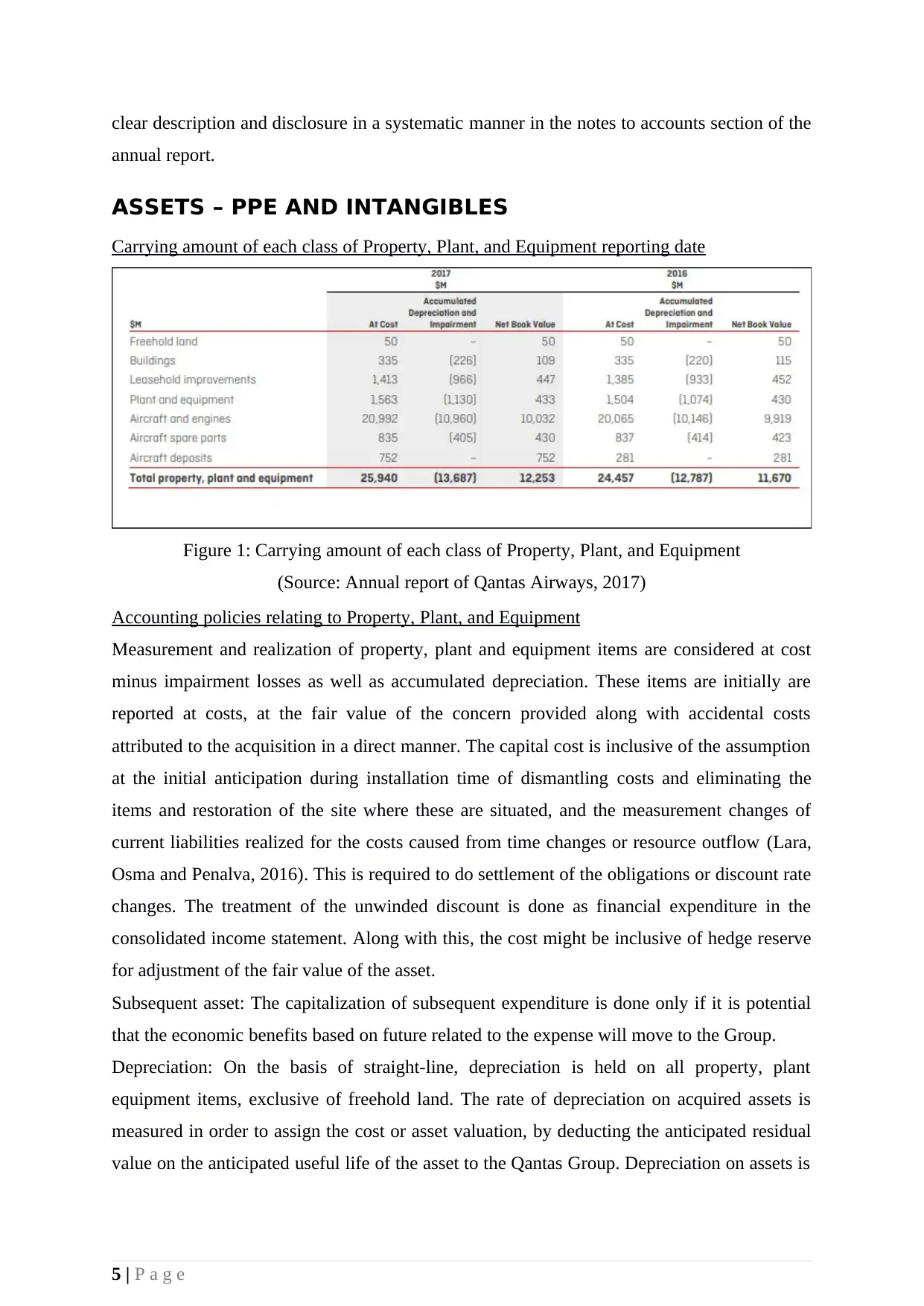
clear description and disclosure in a systematic manner in the notes to accounts section of the
annual report.
ASSETS – PPE AND INTANGIBLES
Carrying amount of each class of Property, Plant, and Equipment reporting date
Figure 1: Carrying amount of each class of Property, Plant, and Equipment
(Source: Annual report of Qantas Airways, 2017)
Accounting policies relating to Property, Plant, and Equipment
Measurement and realization of property, plant and equipment items are considered at cost
minus impairment losses as well as accumulated depreciation. These items are initially are
reported at costs, at the fair value of the concern provided along with accidental costs
attributed to the acquisition in a direct manner. The capital cost is inclusive of the assumption
at the initial anticipation during installation time of dismantling costs and eliminating the
items and restoration of the site where these are situated, and the measurement changes of
current liabilities realized for the costs caused from time changes or resource outflow (Lara,
Osma and Penalva, 2016). This is required to do settlement of the obligations or discount rate
changes. The treatment of the unwinded discount is done as financial expenditure in the
consolidated income statement. Along with this, the cost might be inclusive of hedge reserve
for adjustment of the fair value of the asset.
Subsequent asset: The capitalization of subsequent expenditure is done only if it is potential
that the economic benefits based on future related to the expense will move to the Group.
Depreciation: On the basis of straight-line, depreciation is held on all property, plant
equipment items, exclusive of freehold land. The rate of depreciation on acquired assets is
measured in order to assign the cost or asset valuation, by deducting the anticipated residual
value on the anticipated useful life of the asset to the Qantas Group. Depreciation on assets is
5 | P a g e
annual report.
ASSETS – PPE AND INTANGIBLES
Carrying amount of each class of Property, Plant, and Equipment reporting date
Figure 1: Carrying amount of each class of Property, Plant, and Equipment
(Source: Annual report of Qantas Airways, 2017)
Accounting policies relating to Property, Plant, and Equipment
Measurement and realization of property, plant and equipment items are considered at cost
minus impairment losses as well as accumulated depreciation. These items are initially are
reported at costs, at the fair value of the concern provided along with accidental costs
attributed to the acquisition in a direct manner. The capital cost is inclusive of the assumption
at the initial anticipation during installation time of dismantling costs and eliminating the
items and restoration of the site where these are situated, and the measurement changes of
current liabilities realized for the costs caused from time changes or resource outflow (Lara,
Osma and Penalva, 2016). This is required to do settlement of the obligations or discount rate
changes. The treatment of the unwinded discount is done as financial expenditure in the
consolidated income statement. Along with this, the cost might be inclusive of hedge reserve
for adjustment of the fair value of the asset.
Subsequent asset: The capitalization of subsequent expenditure is done only if it is potential
that the economic benefits based on future related to the expense will move to the Group.
Depreciation: On the basis of straight-line, depreciation is held on all property, plant
equipment items, exclusive of freehold land. The rate of depreciation on acquired assets is
measured in order to assign the cost or asset valuation, by deducting the anticipated residual
value on the anticipated useful life of the asset to the Qantas Group. Depreciation on assets is
5 | P a g e
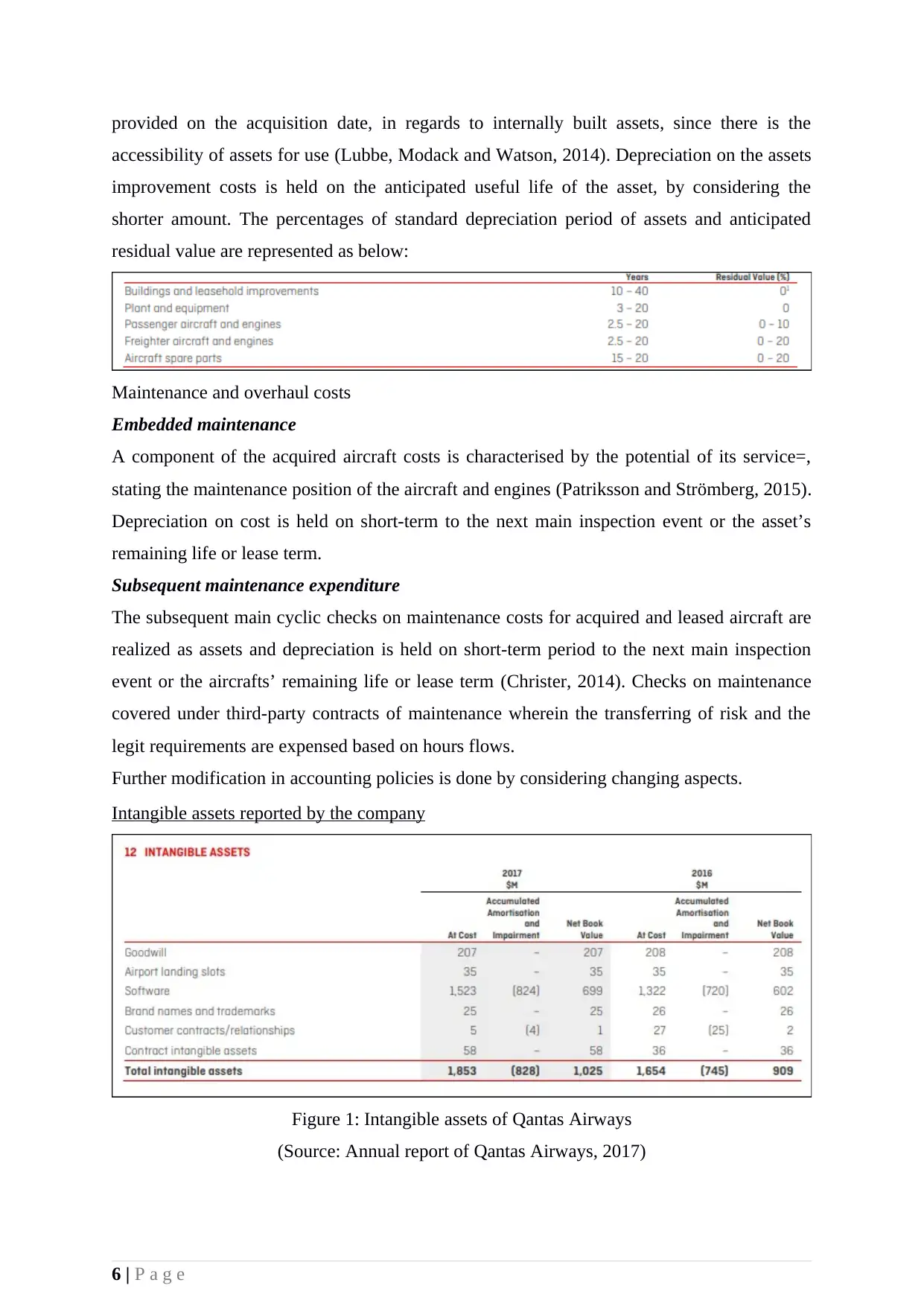
provided on the acquisition date, in regards to internally built assets, since there is the
accessibility of assets for use (Lubbe, Modack and Watson, 2014). Depreciation on the assets
improvement costs is held on the anticipated useful life of the asset, by considering the
shorter amount. The percentages of standard depreciation period of assets and anticipated
residual value are represented as below:
Maintenance and overhaul costs
Embedded maintenance
A component of the acquired aircraft costs is characterised by the potential of its service=,
stating the maintenance position of the aircraft and engines (Patriksson and Strömberg, 2015).
Depreciation on cost is held on short-term to the next main inspection event or the asset’s
remaining life or lease term.
Subsequent maintenance expenditure
The subsequent main cyclic checks on maintenance costs for acquired and leased aircraft are
realized as assets and depreciation is held on short-term period to the next main inspection
event or the aircrafts’ remaining life or lease term (Christer, 2014). Checks on maintenance
covered under third-party contracts of maintenance wherein the transferring of risk and the
legit requirements are expensed based on hours flows.
Further modification in accounting policies is done by considering changing aspects.
Intangible assets reported by the company
Figure 1: Intangible assets of Qantas Airways
(Source: Annual report of Qantas Airways, 2017)
6 | P a g e
accessibility of assets for use (Lubbe, Modack and Watson, 2014). Depreciation on the assets
improvement costs is held on the anticipated useful life of the asset, by considering the
shorter amount. The percentages of standard depreciation period of assets and anticipated
residual value are represented as below:
Maintenance and overhaul costs
Embedded maintenance
A component of the acquired aircraft costs is characterised by the potential of its service=,
stating the maintenance position of the aircraft and engines (Patriksson and Strömberg, 2015).
Depreciation on cost is held on short-term to the next main inspection event or the asset’s
remaining life or lease term.
Subsequent maintenance expenditure
The subsequent main cyclic checks on maintenance costs for acquired and leased aircraft are
realized as assets and depreciation is held on short-term period to the next main inspection
event or the aircrafts’ remaining life or lease term (Christer, 2014). Checks on maintenance
covered under third-party contracts of maintenance wherein the transferring of risk and the
legit requirements are expensed based on hours flows.
Further modification in accounting policies is done by considering changing aspects.
Intangible assets reported by the company
Figure 1: Intangible assets of Qantas Airways
(Source: Annual report of Qantas Airways, 2017)
6 | P a g e
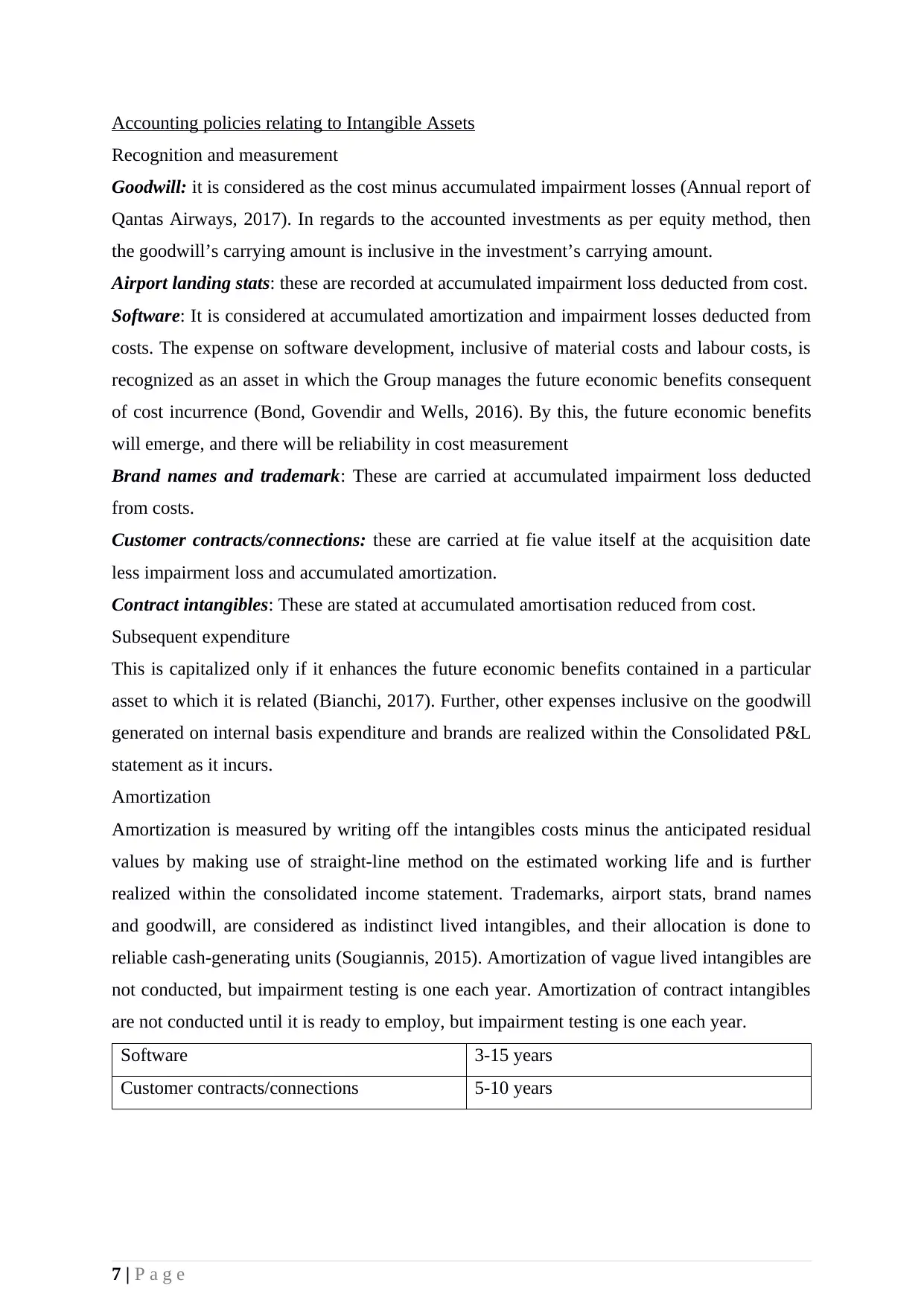
Accounting policies relating to Intangible Assets
Recognition and measurement
Goodwill: it is considered as the cost minus accumulated impairment losses (Annual report of
Qantas Airways, 2017). In regards to the accounted investments as per equity method, then
the goodwill’s carrying amount is inclusive in the investment’s carrying amount.
Airport landing stats: these are recorded at accumulated impairment loss deducted from cost.
Software: It is considered at accumulated amortization and impairment losses deducted from
costs. The expense on software development, inclusive of material costs and labour costs, is
recognized as an asset in which the Group manages the future economic benefits consequent
of cost incurrence (Bond, Govendir and Wells, 2016). By this, the future economic benefits
will emerge, and there will be reliability in cost measurement
Brand names and trademark: These are carried at accumulated impairment loss deducted
from costs.
Customer contracts/connections: these are carried at fie value itself at the acquisition date
less impairment loss and accumulated amortization.
Contract intangibles: These are stated at accumulated amortisation reduced from cost.
Subsequent expenditure
This is capitalized only if it enhances the future economic benefits contained in a particular
asset to which it is related (Bianchi, 2017). Further, other expenses inclusive on the goodwill
generated on internal basis expenditure and brands are realized within the Consolidated P&L
statement as it incurs.
Amortization
Amortization is measured by writing off the intangibles costs minus the anticipated residual
values by making use of straight-line method on the estimated working life and is further
realized within the consolidated income statement. Trademarks, airport stats, brand names
and goodwill, are considered as indistinct lived intangibles, and their allocation is done to
reliable cash-generating units (Sougiannis, 2015). Amortization of vague lived intangibles are
not conducted, but impairment testing is one each year. Amortization of contract intangibles
are not conducted until it is ready to employ, but impairment testing is one each year.
Software 3-15 years
Customer contracts/connections 5-10 years
7 | P a g e
Recognition and measurement
Goodwill: it is considered as the cost minus accumulated impairment losses (Annual report of
Qantas Airways, 2017). In regards to the accounted investments as per equity method, then
the goodwill’s carrying amount is inclusive in the investment’s carrying amount.
Airport landing stats: these are recorded at accumulated impairment loss deducted from cost.
Software: It is considered at accumulated amortization and impairment losses deducted from
costs. The expense on software development, inclusive of material costs and labour costs, is
recognized as an asset in which the Group manages the future economic benefits consequent
of cost incurrence (Bond, Govendir and Wells, 2016). By this, the future economic benefits
will emerge, and there will be reliability in cost measurement
Brand names and trademark: These are carried at accumulated impairment loss deducted
from costs.
Customer contracts/connections: these are carried at fie value itself at the acquisition date
less impairment loss and accumulated amortization.
Contract intangibles: These are stated at accumulated amortisation reduced from cost.
Subsequent expenditure
This is capitalized only if it enhances the future economic benefits contained in a particular
asset to which it is related (Bianchi, 2017). Further, other expenses inclusive on the goodwill
generated on internal basis expenditure and brands are realized within the Consolidated P&L
statement as it incurs.
Amortization
Amortization is measured by writing off the intangibles costs minus the anticipated residual
values by making use of straight-line method on the estimated working life and is further
realized within the consolidated income statement. Trademarks, airport stats, brand names
and goodwill, are considered as indistinct lived intangibles, and their allocation is done to
reliable cash-generating units (Sougiannis, 2015). Amortization of vague lived intangibles are
not conducted, but impairment testing is one each year. Amortization of contract intangibles
are not conducted until it is ready to employ, but impairment testing is one each year.
Software 3-15 years
Customer contracts/connections 5-10 years
7 | P a g e
Secure Best Marks with AI Grader
Need help grading? Try our AI Grader for instant feedback on your assignments.
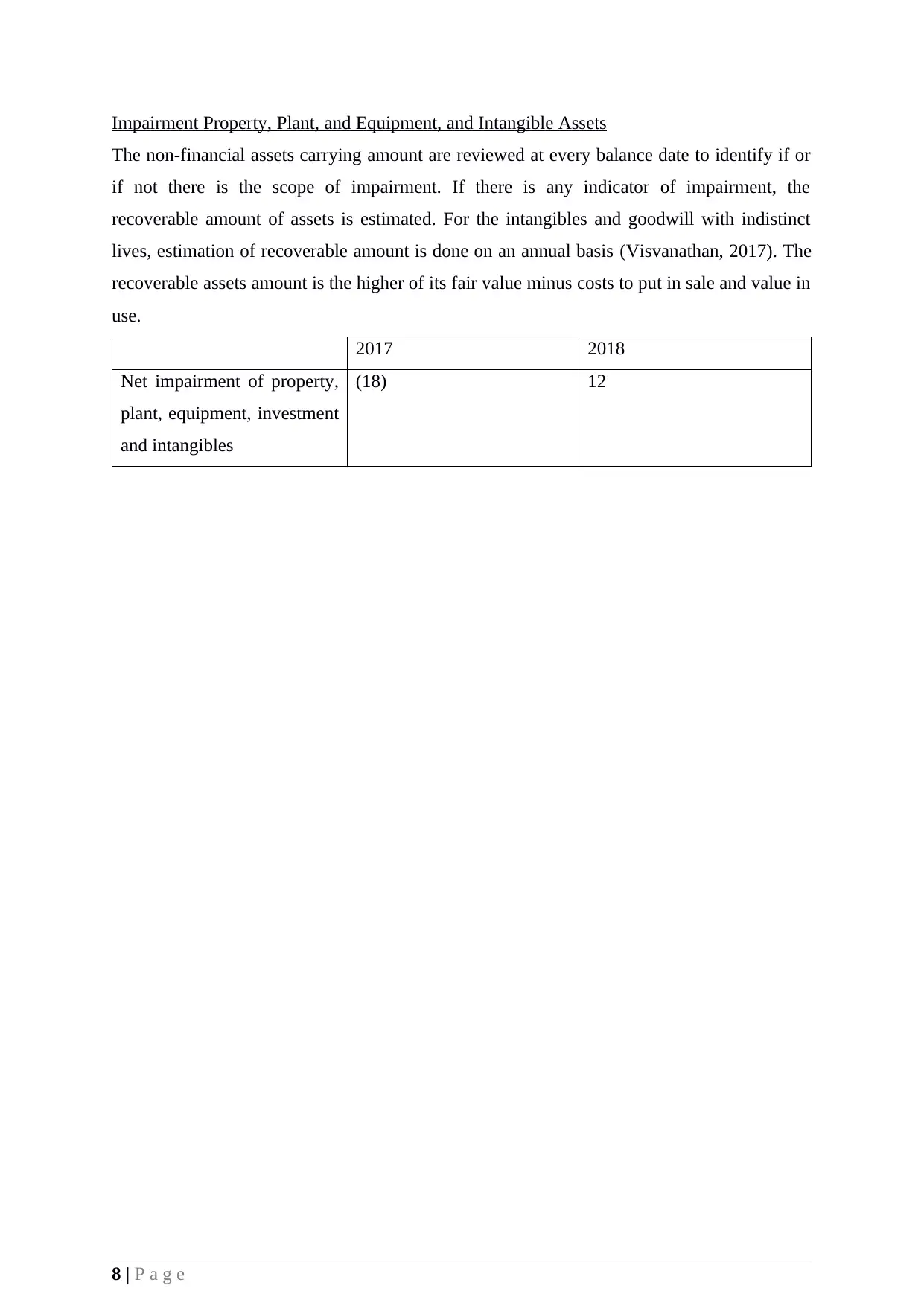
Impairment Property, Plant, and Equipment, and Intangible Assets
The non-financial assets carrying amount are reviewed at every balance date to identify if or
if not there is the scope of impairment. If there is any indicator of impairment, the
recoverable amount of assets is estimated. For the intangibles and goodwill with indistinct
lives, estimation of recoverable amount is done on an annual basis (Visvanathan, 2017). The
recoverable assets amount is the higher of its fair value minus costs to put in sale and value in
use.
2017 2018
Net impairment of property,
plant, equipment, investment
and intangibles
(18) 12
8 | P a g e
The non-financial assets carrying amount are reviewed at every balance date to identify if or
if not there is the scope of impairment. If there is any indicator of impairment, the
recoverable amount of assets is estimated. For the intangibles and goodwill with indistinct
lives, estimation of recoverable amount is done on an annual basis (Visvanathan, 2017). The
recoverable assets amount is the higher of its fair value minus costs to put in sale and value in
use.
2017 2018
Net impairment of property,
plant, equipment, investment
and intangibles
(18) 12
8 | P a g e
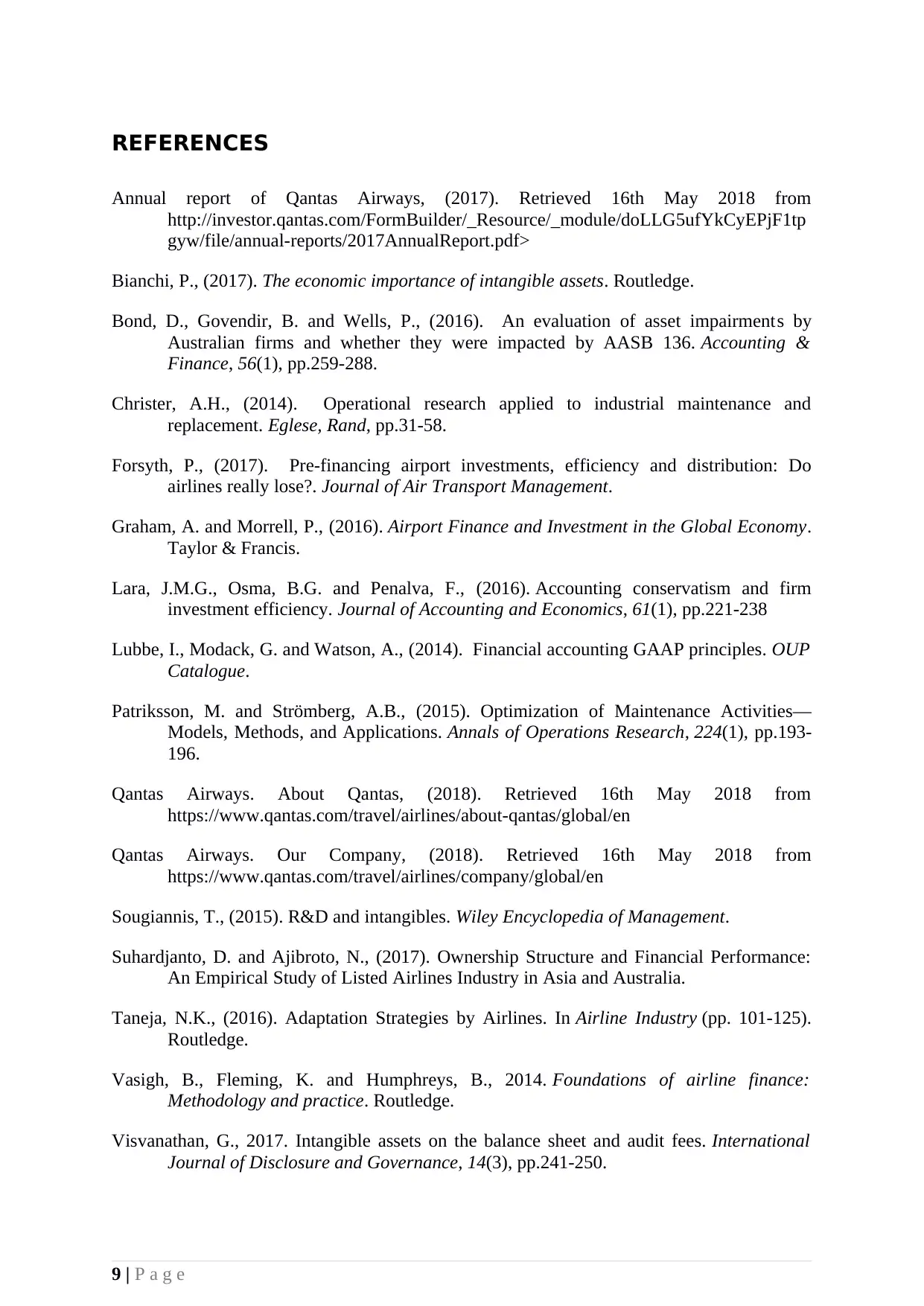
REFERENCES
Annual report of Qantas Airways, (2017). Retrieved 16th May 2018 from
http://investor.qantas.com/FormBuilder/_Resource/_module/doLLG5ufYkCyEPjF1tp
gyw/file/annual-reports/2017AnnualReport.pdf>
Bianchi, P., (2017). The economic importance of intangible assets. Routledge.
Bond, D., Govendir, B. and Wells, P., (2016). An evaluation of asset impairments by
Australian firms and whether they were impacted by AASB 136. Accounting &
Finance, 56(1), pp.259-288.
Christer, A.H., (2014). Operational research applied to industrial maintenance and
replacement. Eglese, Rand, pp.31-58.
Forsyth, P., (2017). Pre-financing airport investments, efficiency and distribution: Do
airlines really lose?. Journal of Air Transport Management.
Graham, A. and Morrell, P., (2016). Airport Finance and Investment in the Global Economy.
Taylor & Francis.
Lara, J.M.G., Osma, B.G. and Penalva, F., (2016). Accounting conservatism and firm
investment efficiency. Journal of Accounting and Economics, 61(1), pp.221-238
Lubbe, I., Modack, G. and Watson, A., (2014). Financial accounting GAAP principles. OUP
Catalogue.
Patriksson, M. and Strömberg, A.B., (2015). Optimization of Maintenance Activities—
Models, Methods, and Applications. Annals of Operations Research, 224(1), pp.193-
196.
Qantas Airways. About Qantas, (2018). Retrieved 16th May 2018 from
https://www.qantas.com/travel/airlines/about-qantas/global/en
Qantas Airways. Our Company, (2018). Retrieved 16th May 2018 from
https://www.qantas.com/travel/airlines/company/global/en
Sougiannis, T., (2015). R&D and intangibles. Wiley Encyclopedia of Management.
Suhardjanto, D. and Ajibroto, N., (2017). Ownership Structure and Financial Performance:
An Empirical Study of Listed Airlines Industry in Asia and Australia.
Taneja, N.K., (2016). Adaptation Strategies by Airlines. In Airline Industry (pp. 101-125).
Routledge.
Vasigh, B., Fleming, K. and Humphreys, B., 2014. Foundations of airline finance:
Methodology and practice. Routledge.
Visvanathan, G., 2017. Intangible assets on the balance sheet and audit fees. International
Journal of Disclosure and Governance, 14(3), pp.241-250.
9 | P a g e
Annual report of Qantas Airways, (2017). Retrieved 16th May 2018 from
http://investor.qantas.com/FormBuilder/_Resource/_module/doLLG5ufYkCyEPjF1tp
gyw/file/annual-reports/2017AnnualReport.pdf>
Bianchi, P., (2017). The economic importance of intangible assets. Routledge.
Bond, D., Govendir, B. and Wells, P., (2016). An evaluation of asset impairments by
Australian firms and whether they were impacted by AASB 136. Accounting &
Finance, 56(1), pp.259-288.
Christer, A.H., (2014). Operational research applied to industrial maintenance and
replacement. Eglese, Rand, pp.31-58.
Forsyth, P., (2017). Pre-financing airport investments, efficiency and distribution: Do
airlines really lose?. Journal of Air Transport Management.
Graham, A. and Morrell, P., (2016). Airport Finance and Investment in the Global Economy.
Taylor & Francis.
Lara, J.M.G., Osma, B.G. and Penalva, F., (2016). Accounting conservatism and firm
investment efficiency. Journal of Accounting and Economics, 61(1), pp.221-238
Lubbe, I., Modack, G. and Watson, A., (2014). Financial accounting GAAP principles. OUP
Catalogue.
Patriksson, M. and Strömberg, A.B., (2015). Optimization of Maintenance Activities—
Models, Methods, and Applications. Annals of Operations Research, 224(1), pp.193-
196.
Qantas Airways. About Qantas, (2018). Retrieved 16th May 2018 from
https://www.qantas.com/travel/airlines/about-qantas/global/en
Qantas Airways. Our Company, (2018). Retrieved 16th May 2018 from
https://www.qantas.com/travel/airlines/company/global/en
Sougiannis, T., (2015). R&D and intangibles. Wiley Encyclopedia of Management.
Suhardjanto, D. and Ajibroto, N., (2017). Ownership Structure and Financial Performance:
An Empirical Study of Listed Airlines Industry in Asia and Australia.
Taneja, N.K., (2016). Adaptation Strategies by Airlines. In Airline Industry (pp. 101-125).
Routledge.
Vasigh, B., Fleming, K. and Humphreys, B., 2014. Foundations of airline finance:
Methodology and practice. Routledge.
Visvanathan, G., 2017. Intangible assets on the balance sheet and audit fees. International
Journal of Disclosure and Governance, 14(3), pp.241-250.
9 | P a g e

10 | P a g e
1 out of 13
Related Documents
Your All-in-One AI-Powered Toolkit for Academic Success.
+13062052269
info@desklib.com
Available 24*7 on WhatsApp / Email
![[object Object]](/_next/static/media/star-bottom.7253800d.svg)
Unlock your academic potential
© 2024 | Zucol Services PVT LTD | All rights reserved.





